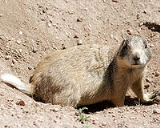
White-tailed Prairie Dog
Encyclopedia
The white-tailed prairie dog (Cynomys leucurus) is found in western Wyoming
and western Colorado
with small areas in eastern Utah
and southern Montana
. The largest populations are in Wyoming where they are known colloquially as "chiselers". This prairie dog
species lives between 5,000 and 10,000 feet, generally a higher elevation than other prairie dog species. Its predators include black-footed ferrets, badgers, and golden eagles.
, with a status
of least concern, last assessed in 1996. Petitions have been made to protect the white-tailed prairie dog, but they have been denied by the United States Fish and Wildlife Service
due to insufficient scientific data describing current population trends. This denial is being reconsidered, because former deputy assistant secretary Julie MacDonald
has been found to have improperly influenced the scientific basis of the denial. Groups such as the Biodiversity Conservation Alliance are working to get this animal on the list.
Wyoming
Wyoming is a state in the mountain region of the Western United States. The western two thirds of the state is covered mostly with the mountain ranges and rangelands in the foothills of the Eastern Rocky Mountains, while the eastern third of the state is high elevation prairie known as the High...
and western Colorado
Colorado
Colorado is a U.S. state that encompasses much of the Rocky Mountains as well as the northeastern portion of the Colorado Plateau and the western edge of the Great Plains...
with small areas in eastern Utah
Utah
Utah is a state in the Western United States. It was the 45th state to join the Union, on January 4, 1896. Approximately 80% of Utah's 2,763,885 people live along the Wasatch Front, centering on Salt Lake City. This leaves vast expanses of the state nearly uninhabited, making the population the...
and southern Montana
Montana
Montana is a state in the Western United States. The western third of Montana contains numerous mountain ranges. Smaller, "island ranges" are found in the central third of the state, for a total of 77 named ranges of the Rocky Mountains. This geographical fact is reflected in the state's name,...
. The largest populations are in Wyoming where they are known colloquially as "chiselers". This prairie dog
Prairie dog
Prairie dogs are burrowing rodents native to the grasslands of North America. There are five different species of prairie dogs: black-tailed, white-tailed, Gunnison's, Utah and Mexican prairie dogs. They are a type of ground squirrel, found in the United States, Canada and Mexico...
species lives between 5,000 and 10,000 feet, generally a higher elevation than other prairie dog species. Its predators include black-footed ferrets, badgers, and golden eagles.
Description
The white-tailed prairie dog is tan-brown in color, with large eyes and a dark patch on their cheeks above and below each eye.Conservation status
White-tailed prairie dogs are only in around 8% of their original territory. This has been caused by oil drilling, and habitat loss mainly. It is also threatened by shooting, and a disease called Sylvatic Plague that affects all prairie dogs. This animal lives in small communities that are vulnerable to being wiped out by all of these issues. This species appears in the IUCN Red List of Threatened SpeciesIUCN Red List
The IUCN Red List of Threatened Species , founded in 1963, is the world's most comprehensive inventory of the global conservation status of biological species. The International Union for Conservation of Nature is the world's main authority on the conservation status of species...
, with a status
Conservation status
The conservation status of a group of organisms indicates whether the group is still extant and how likely the group is to become extinct in the near future...
of least concern, last assessed in 1996. Petitions have been made to protect the white-tailed prairie dog, but they have been denied by the United States Fish and Wildlife Service
United States Fish and Wildlife Service
The United States Fish and Wildlife Service is a federal government agency within the United States Department of the Interior dedicated to the management of fish, wildlife, and natural habitats...
due to insufficient scientific data describing current population trends. This denial is being reconsidered, because former deputy assistant secretary Julie MacDonald
Julie MacDonald
Julie A. MacDonald is a former deputy assistant secretary for Fish and Wildlife and Parks at the United States Department of the Interior...
has been found to have improperly influenced the scientific basis of the denial. Groups such as the Biodiversity Conservation Alliance are working to get this animal on the list.
External links
- Prairie dogs videos (in English)
- Prairie Dogs-Biodiversity Conservation Alliance

